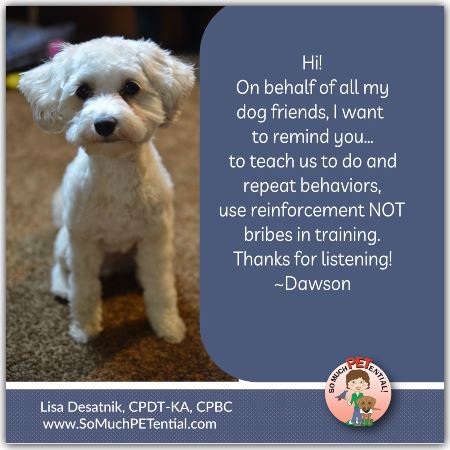On behalf of his dog buddies, Dawson wants to clear up a common misunderstanding about reinforcement vs bribery in dog training.

If, after you call your dog to come and he tells you he has better things to do, you pull out a tasty treat to influence your dog’s decision, you are using bribery not reinforcement in that moment. Sure, your dog may come to you that time but that treat hasn’t really taught your dog to come when called in the future. And, if he does come to get the treat and then is locked in a crate or room all alone for hours – or something else he does not enjoy – guess what? Even the temptation of that treat may not be enough to get your dog to come the next time.
If you hold a piece of meat in your hand that is held in front of your body while you ask your dog to sit, you are also using bribery instead of reinforcement. Sure, your dog may sit and do it quickly but he more than likely will be focused on that yummy treat you are holding right the whole time.
Let’s set the record straight about reinforcement vs bribery in dog training.
Reinforcement is a consequence to a behavior that increases the probability of that behavior happening again. Known as operant learning, it teaches the contingency between a behavior and a consequence (*If* the behavior occurs, *then* the reinforcement follows). When a behavior has a history of it causing valued outcomes (from the perspective of the learner), that behavior is going to strengthen.
A bribe, however, is something of value offered BEFORE the behavior to influence the likelihood of that behavior occurring in that moment. Bribes do not result in a higher probability of the target behavior occurring in the future. They most certainly don’t strengthen the target behavior. Operant learning is not present with the use of bribes because it is not teaching the contingency between a behavior and its consequence.
Always it is the consequence of a behavior that drives the future rate of that behavior. If what your dog does gets him something of value, you will more than likely see more of that in the future. That value could be distance from something aversive or closer to/more of something pleasurable. Your pet is constantly making decisions based upon what past experience has taught him.
A fun part of using reinforcement is it is ever changing. At any given time, your dog may value something different. In the morning, he may value active play time but after a long walk he may value rest. He may value the opportunity to greet people, play with another dog, play with you, sniff the fire hydrant, or just go outside. While food is great to use in teaching behaviors (you can get a lot more repetitions in during a lesson with treat reinforcers vs opportunities to play), ultimately you have SO many options for building value for wanted behaviors.







